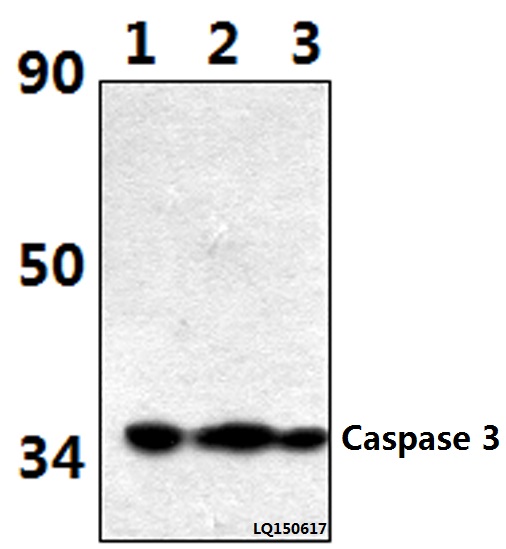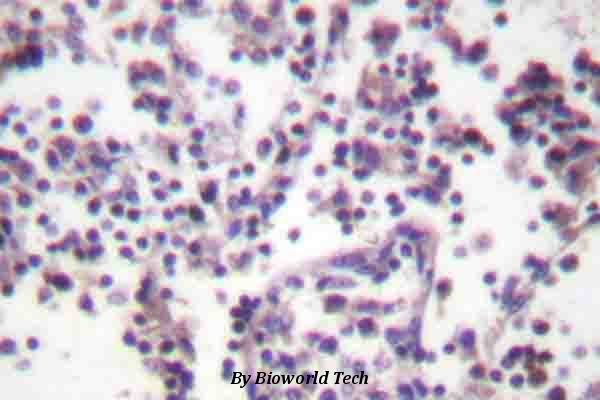Product Name :
Caspase 3 (D146) polyclonal antibody Background :
Caspase 3 (also known as CPP32, YAMA and apopain) is the most extensively studied apoptotic protein among caspase family members. Caspase 3 is synthesized as inactive pro enzyme that is processed in cells undergoing apoptosis by self proteolysis and/or cleavage by other upstream proteases (e.g. Caspases 8, 9 and 10).The processed form of Caspase 3 consists of large (17kD) and small (12kD) subunits which associate to form an active enzyme. Caspase 3 is cleaved at Asp28 - Ser29 and Asp175 - Ser176. The active Caspase 3 proteolytically cleaves and activates other caspases (e.g. Caspases 6, 7 and 9), as well as relevant targets in the cells (e.g. PARP and DFF). Product :
Rabbit IgG, 1mg/ml in PBS with 0.02% sodium azide, 50% glycerol, pH7.2 Storage&Stability :
Store at 4°C short term. Aliquot and store at -20°C long term. Avoid freeze-thaw cycles. Specificity :
Caspase 3 (D146) polyclonal antibody detects endogenous levels of Caspase 3 protein. Immunogen :
Synthetic peptide, corresponding to amino acids 120-170 of Human Caspase 3. Conjugate :
Unconjugated Modification :
Unmodification
Caspase 3 (D146) polyclonal antibody Background :
Caspase 3 (also known as CPP32, YAMA and apopain) is the most extensively studied apoptotic protein among caspase family members. Caspase 3 is synthesized as inactive pro enzyme that is processed in cells undergoing apoptosis by self proteolysis and/or cleavage by other upstream proteases (e.g. Caspases 8, 9 and 10).The processed form of Caspase 3 consists of large (17kD) and small (12kD) subunits which associate to form an active enzyme. Caspase 3 is cleaved at Asp28 - Ser29 and Asp175 - Ser176. The active Caspase 3 proteolytically cleaves and activates other caspases (e.g. Caspases 6, 7 and 9), as well as relevant targets in the cells (e.g. PARP and DFF). Product :
Rabbit IgG, 1mg/ml in PBS with 0.02% sodium azide, 50% glycerol, pH7.2 Storage&Stability :
Store at 4°C short term. Aliquot and store at -20°C long term. Avoid freeze-thaw cycles. Specificity :
Caspase 3 (D146) polyclonal antibody detects endogenous levels of Caspase 3 protein. Immunogen :
Synthetic peptide, corresponding to amino acids 120-170 of Human Caspase 3. Conjugate :
Unconjugated Modification :
Unmodification
-
 Western blot (WB) analysis of Caspase 3 (D146) polyclonal antibody at 1:500 dilution Lane1:Hela whole cell lysate(40ug) Lane2:Hela treated with H2O2 (100nmol/ml, 25min, Na3O4V) whole cell lysate (40ug) Lane3:Hela treated with H2O2 (100nmol/ml, 25min, λ-ppase) whole cell lysate (40ug)
Western blot (WB) analysis of Caspase 3 (D146) polyclonal antibody at 1:500 dilution Lane1:Hela whole cell lysate(40ug) Lane2:Hela treated with H2O2 (100nmol/ml, 25min, Na3O4V) whole cell lysate (40ug) Lane3:Hela treated with H2O2 (100nmol/ml, 25min, λ-ppase) whole cell lysate (40ug) -
 Immunohistochemistry (IHC) analyzes of Caspase 3 (D146) pAb in paraffin-embedded human lymph node tissue.
Immunohistochemistry (IHC) analyzes of Caspase 3 (D146) pAb in paraffin-embedded human lymph node tissue.
Sonic hedgehog through Gli2 and Gli3 is required for the proper development of placental labyrinth
PMCID: Pubmed No.:25695606
ART-induced biophysical and biochemical alterations of Jurkat cell membrane
PMCID: Pubmed No.:20888245
TRAIL and doxorubicin combination enhances anti-glioblastoma effect based on passive tumor targeting of liposomes
PMCID: Pubmed No.:21609741
Exogenous melatonin modulates apoptosis in the mouse brain induced by high-LET carbon ion irradiation
PMCID: Pubmed No.:21812816
MicroRNA-195 Promotes Apoptosis in Mouse Podocytes via Enhanced Caspase Activity Driven by BCL2 Insufficiency
PMCID: Pubmed No.:22123611
The role of radix hedysari polysaccharide on the human umbilical vein endothelial cells induced by high glucose
PMCID: Pubmed No.:22385890
MicroRNA-409-3p regulates cell proliferation and apoptosis by targeting PHF10 in gastric cancer
PMCID: Pubmed No.:22388101
In vitro Anti-Angiogenesis Effects and Active Constituents of the Saponin Fraction From Gleditsia sinensis
PMCID: Pubmed No.:22505594
Combination of TRAIL and actinomycin D liposomes enhances antitumor effect in non-small cell lung cancer
PMCID: Pubmed No.:22619505
Induction and Mechanism of Apoptosis by Hydroxycamptothecin in Human Tenon's Capsule Fibroblasts
PMCID: Pubmed No.:22661476
Reactive oxygen species-mediated mitochondrial pathway is involved in Baohuoside I-induced apoptosis in human non-small cell lung cancer
PMCID: Pubmed No.:22687635
Down regulation of differentiated embryonic chondrocytes 1 (DEC1) is involved in 8-methoxypsoralen-induced apoptosis in HepG2 cells
PMCID: Pubmed No.:22796345
NG, a novel PABA/NO-based oleanolic acid derivative, induces human hepatoma cell apoptosis via a ROS/MAPK- dependent mitochondrial pathway
PMCID: Pubmed No.:22824464
Phycocyanin may suppress d-galactose-induced human lens epithelial cell apoptosis through mitochondrial and unfolded protein response pathways
PMCID: Pubmed No.:23036742
Lentivirus-mediated Sirt1 shRNA and resveratrol independently induce porcine preadipocyte apoptosis by canonical apoptotic pathway
PMCID: Pubmed No.:23065251
T63, a New 4-Arylidene Curcumin Analogue induces cell cycle arrest and apoptosis through activation of Reactive Oxygen Species-FOXO3a pathway in lung cancer cells
PMCID: Pubmed No.:23085518
Effects of Tetramethylpyrazine on Neuronal Apoptosis in the Superficial Dorsal Horn in a Rat Model of Neuropathic Pain
PMCID: Pubmed No.:23227794
Osteopontin Splice Variants Differentially Exert Clinicopathological Features and Biological Functions in Gastric Cancer
PMCID: Pubmed No.:23289017
miR-17-5p/20a are important markers for gastric cancer and murine double minute 2 participates in their functional regulation
PMCID: Pubmed No.:23333058
Acetylcholine Attenuates Hypoxia/ Reoxygenation-Induced Mitochondrial and Cytosolic ROS Formation in H9c2 Cells via M2 Acetylcholine Receptor
PMCID: Pubmed No.:23407103
2-methoxyjuglone induces apoptosis in HepG2 human hepatocellular carcinoma cells and exhibits in vivo antitumor activity in a H22 mouse hepatocellular carcinoma model.
PMCID: Pubmed No.:23597099
The anti-apoptotic and neuro-protective effects of human umbilical cord blood mesenchymal stem cells (hUCB-MSCs) on acute optic nerve injury is transient
PMCID: Pubmed No.:23933426
Effects of Nicorandil in Neuroprotective Activation of PI3K/AKT Pathways in a Cellular Model of Alzheimer's Disease
PMCID: Pubmed No.:24008440
ONTD induces apoptosis of human hepatoma Bel-7402 cells via a MAPK-dependent mitochondrial pathway and the depletion of intracellular glutathione
PMCID: Pubmed No.:24036456
IGF-1 gene-modified muscle-derived stem cells are resistant to oxidative stress via enhanced activation of IGF-1R/PI3K/AKT signaling and secretion of VEGF
PMCID: Pubmed No.:24126783
(S)-ZJM-289 Preconditioning Induces a Late Phase Protection Against Nervous Injury Induced by Transient Cerebral Ischemia and Oxygen-Glucose Deprivation
PMCID: Pubmed No.:24277159
Decoy Oligonucleotide Rescues IGF1R Expression from MicroRNA-223 Suppression
PMCID: Pubmed No.:24324762
Fluoride‐induced apoptosis and expressions of caspase proteins in the kidney of carp (Cyprinus carpio)
PMCID: Pubmed No.:24459041
Norisoboldine induces apoptosis of fibroblast-like synoviocytes from adjuvant-induced arthritis rats
PMCID: Pubmed No.:24613208
ZnO nanoparticle-induced oxidative stress triggers apoptosis by activating JNK signaling pathway in cultured primary astrocytes
PMCID: Pubmed No.:24624962
Apelin-13 protects the brain against ischemia/reperfusion injury through activating PI3K/Akt and ERK1/2 signaling pathways
PMCID: Pubmed No.:24686182
Ribonuclease inhibitor up-regulation inhibits the growth and induces apoptosis in murine melanoma cells through repression of angiogenin and ILK/PI3K/AKT signaling pathway.
PMCID: Pubmed No.:24769129
Hydrogen Sulfide Attenuates the Recruitment of CD11b+ Gr-1+ Myeloid Cells and Regulates Bax/Bcl-2 Signaling in Myocardial Ischemia Injury
PMCID: Pubmed No.:24758901
Hyperbaric Oxygen Suppresses Hypoxic-Ischemic Brain Damage in Newborn Rats
PMCID: Pubmed No.:24762865
Mark4 promotes adipogenesis and triggers apoptosis in 3T3-L1 adipocytes by activating JNK1 and inhibiting p38MAPK pathways.
PMCID: Pubmed No.:24989893
Chronic sleep restriction induces changes in the mandibular condylar cartilage of rats: roles of Akt, Bad and Caspase-3 (Application: IHC)
PMCID: Pubmed No.:25356113
A new cellular model of pathological TDP-43: The neurotoxicity of stably expressed CTF25 of TDP-43 depends on the proteasome
PMCID: Pubmed No.:25270903
Effect of vitamin C administration on hydrogen peroxide‑induced cytotoxicity in periodontal ligament cells
PMCID: Pubmed No.:25333298
Suppression of epithelial-mesenchymal transition and apoptotic pathways by miR-294/302 family synergistically blocks let-7-induced silencing of self-renewal in embryonic stem cells.
PMCID: Pubmed No.:25501598
Neuroprotective Effect of Sodium Butyrate against Cerebral Ischemia/Reperfusion Injury in Mice
PMCID: Pubmed No.:26064905
Ameliorating the Effect of Astragaloside IV on Learning and Memory Deficit after Chronic Cerebral Hypoperfusion in Rats
PMCID: Pubmed No.:25625683
Inhibitory effect of epirubicin-loaded lipid microbubbles with conjugated anti-ABCG2 antibody combined with therapeutic ultrasound on multiple myeloma cancer stem cells.
PMCID: Pubmed No.:26204324
Phenethyl isothiocyanate enhances adriamycin‑induced apoptosis in osteosarcoma cells
PMCID: Pubmed No.:26252906
Gambogic acid enhances the radiosensitivity of human esophageal cancer cells by inducing reactive oxygen species via targeting Akt/mTOR pathway
PMCID: Pubmed No.:26318432
Extracellular Vesicles Derived from Bone Marrow Mesenchymal Stem Cells Protect against Experimental Colitis via Attenuating Colon Inflammation, Oxidative Stress and Apoptosis.
PMCID: Pubmed No.:26469068
Racemic oleracein E increases the survival rate and attenuates memory impairment in D-galactose/NaNO 2-induced senescent mice
PMCID: Pubmed No.:27064004
PFR peptide, one of the antimicrobial peptides identified from the derivatives of lactoferrin, induces necrosis in leukemia cells
PMCID: Pubmed No.:26860588
Persistent mitoKATP Activation Is Involved in the Isoflurane-induced Cytotoxicity
PMCID: Pubmed No.:26803495
ZFX Facilitates Cell Proliferation and Imatinib Resistance in Chronic Myeloid Leukemia Cells
PMCID: Pubmed No.:26912059
YiQiFuMai powder injection attenuates ischemia/reperfusion-induced myocardial apoptosis through AMPK activation
PMCID: Pubmed No.:27072567
Chronic sleep restriction induces changes in the mandibular condylar cartilage of rats: roles of Akt, Bad and Caspase-3 (Application: IHC)
PMCID: Pubmed No.:25356113
A new cellular model of pathological TDP-43: The neurotoxicity of stably expressed CTF25 of TDP-43 depends on the proteasome
PMCID: Pubmed No.:25270903
Effect of vitamin C administration on hydrogen peroxide‑induced cytotoxicity in periodontal ligament cells
PMCID: Pubmed No.:25333298
Suppression of epithelial-mesenchymal transition and apoptotic pathways by miR-294/302 family synergistically blocks let-7-induced silencing of self-renewal in embryonic stem cells.
PMCID: Pubmed No.:25501598
IGF-1 gene-modified muscle-derived stem cells are resistant to oxidative stress via enhanced activation of IGF-1R/PI3K/AKT signaling and secretion of VEGF
PMCID: Pubmed No.:24126783
(S)-ZJM-289 Preconditioning Induces a Late Phase Protection Against Nervous Injury Induced by Transient Cerebral Ischemia and Oxygen-Glucose Deprivation
PMCID: Pubmed No.:24277159
Extracellular Vesicles Derived from Bone Marrow Mesenchymal Stem Cells Protect against Experimental Colitis via Attenuating Colon Inflammation, Oxidative Stress and Apoptosis.
PMCID: Pubmed No.:26469068
Racemic oleracein E increases the survival rate and attenuates memory impairment in D-galactose/NaNO 2-induced senescent mice
PMCID: Pubmed No.:27064004
PFR peptide, one of the antimicrobial peptides identified from the derivatives of lactoferrin, induces necrosis in leukemia cells
PMCID: Pubmed No.:26860588
Persistent mitoKATP Activation Is Involved in the Isoflurane-induced Cytotoxicity
PMCID: Pubmed No.:26803495
ZFX Facilitates Cell Proliferation and Imatinib Resistance in Chronic Myeloid Leukemia Cells
PMCID: Pubmed No.:26912059
YiQiFuMai powder injection attenuates ischemia/reperfusion-induced myocardial apoptosis through AMPK activation
PMCID: Pubmed No.:27072567
Ribonuclease inhibitor up-regulation inhibits the growth and induces apoptosis in murine melanoma cells through repression of angiogenin and ILK/PI3K/AKT signaling pathway.
PMCID: Pubmed No.:24769129
Hydrogen Sulfide Attenuates the Recruitment of CD11b+ Gr-1+ Myeloid Cells and Regulates Bax/Bcl-2 Signaling in Myocardial Ischemia Injury
PMCID: Pubmed No.:24758901
Hyperbaric Oxygen Suppresses Hypoxic-Ischemic Brain Damage in Newborn Rats
PMCID: Pubmed No.:24762865
Decoy Oligonucleotide Rescues IGF1R Expression from MicroRNA-223 Suppression
PMCID: Pubmed No.:24324762
Fluoride‐induced apoptosis and expressions of caspase proteins in the kidney of carp (Cyprinus carpio)
PMCID: Pubmed No.:24459041
Norisoboldine induces apoptosis of fibroblast-like synoviocytes from adjuvant-induced arthritis rats
PMCID: Pubmed No.:24613208
ZnO nanoparticle-induced oxidative stress triggers apoptosis by activating JNK signaling pathway in cultured primary astrocytes
PMCID: Pubmed No.:24624962
Apelin-13 protects the brain against ischemia/reperfusion injury through activating PI3K/Akt and ERK1/2 signaling pathways
PMCID: Pubmed No.:24686182
Racemic oleracein E increases the survival rate and attenuates memory impairment in D-galactose/NaNO2-induced senescent mice
PMCID: Pubmed No.:27064004
Phenolic alkaloid oleracein E attenuates oxidative stress and neurotoxicity in AlCl3-treated mice
PMCID: Pubmed No.:29054451
ATRQβ-001 vaccine prevents atherosclerosis in apolipoprotein E-null mice
PMCID: Pubmed No.:26771341
Neuroprotective effects of hydrogen sulfide on sodium azide-induced oxidative stress in PC12 cells
PMCID: Pubmed No.:29115393
Neuroprotective Effect of Sodium Butyrate against Cerebral Ischemia/Reperfusion Injury in Mice
PMCID: Pubmed No.:26064905
Downregulation of DEC1 contributes to the neurotoxicity induced by MPP+ by suppressing PI3K/Akt/GSK3β pathway
PMCID: Pubmed No.:28734031
The stress-response molecule NR4A1 resists ROS-induced pancreatic β-cells apoptosis via WT1
PMCID: Pubmed No.:28342843
Synthesis, antiproliferative and apoptosis-inducing effects of novel asiatic acid derivatives containing α-aminophosphonates
PMCID: Pubmed No.:24262379
Curcumin-cyclodextrin complexes enhanced the anti-cancer effects of curcumin
PMCID: Pubmed No.:27716533
Inhibitory effect of epirubicin-loaded lipid microbubbles with conjugated anti-ABCG2 antibody combined with therapeutic ultrasound on multiple myeloma cancer stem cells
PMCID: Pubmed No.:26204324
Associations between autophagy, the ubiquitin-proteasome system and endoplasmic reticulum stress in hypoxia-deoxygenation or ischemia-reperfusion
PMCID: Pubmed No.:27568838
Clostridium butyricum attenuates cerebral ischemia/reperfusion injury in diabetic mice via modulation of gut microbiota
PMCID: Pubmed No.:27037183
Study on the mitochondrial apoptosis pathways of small cell lung cancer H446 cells induced by Trichinella spiralis muscle larvae ESPs
PMCID: Pubmed No.:28073393
Phenethyl isothiocyanate enhances adriamycin‑induced apoptosis in osteosarcoma cells
PMCID: Pubmed No.:26252906
scAAV9-VEGF prolongs the survival of transgenic ALS mice by promoting activation of M2 microglia and the PI3K/Akt pathway
PMCID: Pubmed No.:27392886
TRAF2 is a Valuable Prognostic Biomarker in Patients with Prostate Cancer
PMCID: Pubmed No.:28855498
Downregulation of Foxc2 enhances apoptosis induced by 5-fluorouracil through activation of MAPK and AKT pathways in colorectal cancer
PMCID: Pubmed No.:26893778
AAV9-IGF1 protects TDP-25 cells from apoptosis and oxidative stress partly via up-regulating the expression of VEGF in vitro
PMCID: Pubmed No.:28108397
Tan IIA inhibits H1299 cell viability through the MDM4‑IAP3 signaling pathway
PMCID: Pubmed No.:29207086
Targeting survivin using a combination of miR‑494 and survivin shRNA has synergistic effects on the suppression of prostate cancer growth
PMCID: Pubmed No.:26718651
LFG-500, a newly synthesized flavonoid, induces apoptosis in human ovarian carcinoma SKOV3 cells with involvement of the reactive oxygen species-mitochondria pathway
PMCID: Pubmed No.:28587346
Lentivirus-induced knockdown of LRP1 induces osteoarthritic-like effects and increases susceptibility to apoptosis in chondrocytes via the nuclear factor-κB pathway
PMCID: Pubmed No.:26170918
Methyl methanesulfonate induces necroptosis in human lung adenoma A549 cells through the PIG-3-reactive oxygen species pathway
PMCID: Pubmed No.:26472723
ING4 expressing oncolytic vaccinia virus promotes anti-tumor efficiency and synergizes with gemcitabine in pancreatic cancer
PMCID: Pubmed No.:29137298
Pyridostigmine Protects Against Diabetic Cardiomyopathy by Regulating Vagal Activity, Gut Microbiota, and Branched-Chain Amino Acid Catabolism in Diabetic Mice
PMCID: Pubmed No.:34084135
AIM2 promotes non‐small‐cell lung cancer cell growth through inflammasome‐dependent pathway
PMCID: Pubmed No.:30953357
Hydrogen sulfide protects against cell damage through modulation of PI3K/Akt/Nrf2 signaling
PMCID: Pubmed No.:31654751
The PI3K inhibitor buparlisib suppresses osteoclast formation and tumour cell growth in bone metastasis of lung cancer, as evidenced by multimodality molecular imaging
PMCID: Pubmed No.:30896825
Myeloid NEMO deficiency promotes tumor immunosuppression partly via MCP1-CCR2 axis
PMCID: Pubmed No.:33428904
Systemic administration of scAAV9-IGF1 extends survival in SOD1G93A ALS mice via inhibiting p38 MAPK and the JNK-mediated apoptosis pathway
PMCID: Pubmed No.:29499331
Chronic restraint stress exacerbates neurological deficits and disrupts the remodeling of the neurovascular unit in a mouse intracerebral hemorrhage model
PMCID: Pubmed No.:31591949
Salubrinal offers neuroprotection through suppressing endoplasmic reticulum stress, autophagy and apoptosis in a mouse traumatic brain injury model
PMCID: Pubmed No.:30851432
Delayed cognitive deficits can be alleviated by calcium antagonist nimodipine by downregulation of apoptosis following whole brain radiotherapy
PMCID: Pubmed No.:30013647
Downregulation of Frizzled-7 induces the apoptosis of hepatocellular carcinoma cells through inhibition of NF-κB
PMCID: Pubmed No.:29731900
Restraint Stress Delays the Recovery of Neurological Impairments and Exacerbates Brain Damages through Activating Endoplasmic Reticulum Stress-mediated Neurodegeneration/Autophagy/Apopotosis post Moderate Traumatic Brain Injury
PMCID: Pubmed No.:35001355
Mechanism of Shiliu Buxue Syrup for anemia using integrated metabolomics and network pharmacology
PMCID: Pubmed No.:35690102
Brain-specific loss of Abcg1 disturbs cholesterol metabolism and aggravates pyroptosis and neurological deficits after traumatic brain injury
PMCID: Pubmed No.:36271611
Nitro-oleic acid ameliorates erectile dysfunction in a streptozotocin-induced rat model of diabetes by inhibiting oxidative stress and apoptosis and activating the NO/cGMP pathway
PMCID: Pubmed No.:37695220
Pramipexole has a neuroprotective effect in spinal cord injury and upregulates D2 receptor expression in the injured spinal cord tissue in rats
PMCID: Pubmed No.:37719118
Bioworld Biotech only provide peptides for our antibodies and do not provide additional peptide customization services.
Price/Size :
USD 368/1mg/vial
Tips:
For phospho antibody, we provide phospho peptide(0.5mg) and non-phospho peptide(0.5mg).Describe :
Blocking peptides are peptides that bind specifically to the target antibody and block antibody binding. These peptide usually contains the epitope recognized by the antibody. Antibodies bound to the blocking peptide no longer bind to the epitope on the target protein. This mechanism is useful when non-specific binding is an issue, for example, in Western blotting (WB) and Immunohistochemistry (IHC). By comparing the staining from the blocked antibody versus the antibody alone, one can see which staining is specific; Specific binding will be absent from the western blot or IHC performed with the neutralized antibody.Formula:
Synthetic peptide was lyophilized with 100% acetonitrile and is supplied as a powder. Reconstitute with 0.1 ml DI water for a final concentration of 10 mg/ml.The purity is >90%,tested by HPLC and MS.
Storage:
The freeze-dried powder is more stable. For short time at 2-8°C. For long term storage store at -20°C.
Note :
This product is for research use only (RUO only). Not for use in diagnostic or therapeutic procedures.
 Caspase 3 (D146) polyclonal antibody
Caspase 3 (D146) polyclonal antibody  Datasheet
Datasheet COA
COA MSDS
MSDS SHIP
SHIP